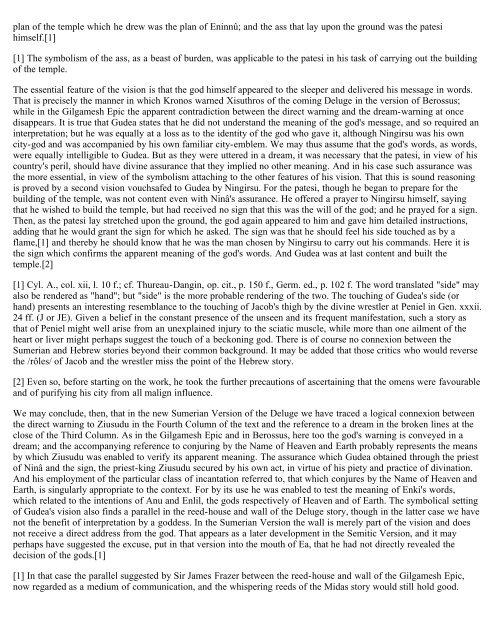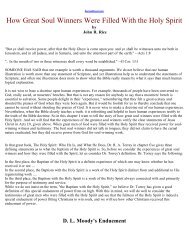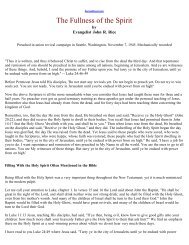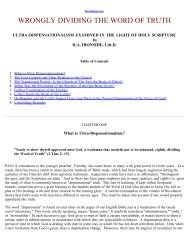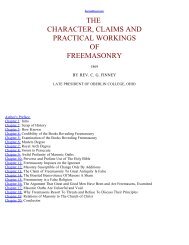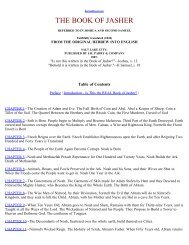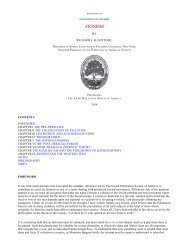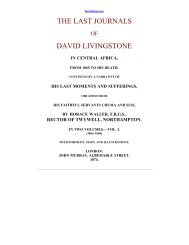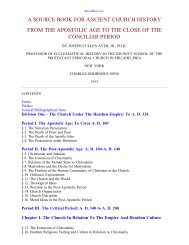Legends of Babylon and Egypt in Relation to Hebrew Tradition.pdf
Legends of Babylon and Egypt in Relation to Hebrew Tradition.pdf
Legends of Babylon and Egypt in Relation to Hebrew Tradition.pdf
Create successful ePaper yourself
Turn your PDF publications into a flip-book with our unique Google optimized e-Paper software.
plan <strong>of</strong> the temple which he drew was the plan <strong>of</strong> En<strong>in</strong>nû; <strong>and</strong> the ass that lay upon the ground was the patesi<br />
himself.[1]<br />
[1] The symbolism <strong>of</strong> the ass, as a beast <strong>of</strong> burden, was applicable <strong>to</strong> the patesi <strong>in</strong> his task <strong>of</strong> carry<strong>in</strong>g out the build<strong>in</strong>g<br />
<strong>of</strong> the temple.<br />
The essential feature <strong>of</strong> the vision is that the god himself appeared <strong>to</strong> the sleeper <strong>and</strong> delivered his message <strong>in</strong> words.<br />
That is precisely the manner <strong>in</strong> which Kronos warned Xisuthros <strong>of</strong> the com<strong>in</strong>g Deluge <strong>in</strong> the version <strong>of</strong> Berossus;<br />
while <strong>in</strong> the Gilgamesh Epic the apparent contradiction between the direct warn<strong>in</strong>g <strong>and</strong> the dream-warn<strong>in</strong>g at once<br />
disappears. It is true that Gudea states that he did not underst<strong>and</strong> the mean<strong>in</strong>g <strong>of</strong> the god's message, <strong>and</strong> so required an<br />
<strong>in</strong>terpretation; but he was equally at a loss as <strong>to</strong> the identity <strong>of</strong> the god who gave it, although N<strong>in</strong>girsu was his own<br />
city-god <strong>and</strong> was accompanied by his own familiar city-emblem. We may thus assume that the god's words, as words,<br />
were equally <strong>in</strong>telligible <strong>to</strong> Gudea. But as they were uttered <strong>in</strong> a dream, it was necessary that the patesi, <strong>in</strong> view <strong>of</strong> his<br />
country's peril, should have div<strong>in</strong>e assurance that they implied no other mean<strong>in</strong>g. And <strong>in</strong> his case such assurance was<br />
the more essential, <strong>in</strong> view <strong>of</strong> the symbolism attach<strong>in</strong>g <strong>to</strong> the other features <strong>of</strong> his vision. That this is sound reason<strong>in</strong>g<br />
is proved by a second vision vouchsafed <strong>to</strong> Gudea by N<strong>in</strong>girsu. For the patesi, though he began <strong>to</strong> prepare for the<br />
build<strong>in</strong>g <strong>of</strong> the temple, was not content even with N<strong>in</strong>â's assurance. He <strong>of</strong>fered a prayer <strong>to</strong> N<strong>in</strong>girsu himself, say<strong>in</strong>g<br />
that he wished <strong>to</strong> build the temple, but had received no sign that this was the will <strong>of</strong> the god; <strong>and</strong> he prayed for a sign.<br />
Then, as the patesi lay stretched upon the ground, the god aga<strong>in</strong> appeared <strong>to</strong> him <strong>and</strong> gave him detailed <strong>in</strong>structions,<br />
add<strong>in</strong>g that he would grant the sign for which he asked. The sign was that he should feel his side <strong>to</strong>uched as by a<br />
flame,[1] <strong>and</strong> thereby he should know that he was the man chosen by N<strong>in</strong>girsu <strong>to</strong> carry out his comm<strong>and</strong>s. Here it is<br />
the sign which confirms the apparent mean<strong>in</strong>g <strong>of</strong> the god's words. And Gudea was at last content <strong>and</strong> built the<br />
temple.[2]<br />
[1] Cyl. A., col. xii, l. 10 f.; cf. Thureau-Dang<strong>in</strong>, op. cit., p. 150 f., Germ. ed., p. 102 f. The word translated "side" may<br />
also be rendered as "h<strong>and</strong>"; but "side" is the more probable render<strong>in</strong>g <strong>of</strong> the two. The <strong>to</strong>uch<strong>in</strong>g <strong>of</strong> Gudea's side (or<br />
h<strong>and</strong>) presents an <strong>in</strong>terest<strong>in</strong>g resemblance <strong>to</strong> the <strong>to</strong>uch<strong>in</strong>g <strong>of</strong> Jacob's thigh by the div<strong>in</strong>e wrestler at Peniel <strong>in</strong> Gen. xxxii.<br />
24 ff. (J or JE). Given a belief <strong>in</strong> the constant presence <strong>of</strong> the unseen <strong>and</strong> its frequent manifestation, such a s<strong>to</strong>ry as<br />
that <strong>of</strong> Peniel might well arise from an unexpla<strong>in</strong>ed <strong>in</strong>jury <strong>to</strong> the sciatic muscle, while more than one ailment <strong>of</strong> the<br />
heart or liver might perhaps suggest the <strong>to</strong>uch <strong>of</strong> a beckon<strong>in</strong>g god. There is <strong>of</strong> course no connexion between the<br />
Sumerian <strong>and</strong> <strong>Hebrew</strong> s<strong>to</strong>ries beyond their common background. It may be added that those critics who would reverse<br />
the /rôles/ <strong>of</strong> Jacob <strong>and</strong> the wrestler miss the po<strong>in</strong>t <strong>of</strong> the <strong>Hebrew</strong> s<strong>to</strong>ry.<br />
[2] Even so, before start<strong>in</strong>g on the work, he <strong>to</strong>ok the further precautions <strong>of</strong> ascerta<strong>in</strong><strong>in</strong>g that the omens were favourable<br />
<strong>and</strong> <strong>of</strong> purify<strong>in</strong>g his city from all malign <strong>in</strong>fluence.<br />
We may conclude, then, that <strong>in</strong> the new Sumerian Version <strong>of</strong> the Deluge we have traced a logical connexion between<br />
the direct warn<strong>in</strong>g <strong>to</strong> Ziusudu <strong>in</strong> the Fourth Column <strong>of</strong> the text <strong>and</strong> the reference <strong>to</strong> a dream <strong>in</strong> the broken l<strong>in</strong>es at the<br />
close <strong>of</strong> the Third Column. As <strong>in</strong> the Gilgamesh Epic <strong>and</strong> <strong>in</strong> Berossus, here <strong>to</strong>o the god's warn<strong>in</strong>g is conveyed <strong>in</strong> a<br />
dream; <strong>and</strong> the accompany<strong>in</strong>g reference <strong>to</strong> conjur<strong>in</strong>g by the Name <strong>of</strong> Heaven <strong>and</strong> Earth probably represents the means<br />
by which Ziusudu was enabled <strong>to</strong> verify its apparent mean<strong>in</strong>g. The assurance which Gudea obta<strong>in</strong>ed through the priest<br />
<strong>of</strong> N<strong>in</strong>â <strong>and</strong> the sign, the priest-k<strong>in</strong>g Ziusudu secured by his own act, <strong>in</strong> virtue <strong>of</strong> his piety <strong>and</strong> practice <strong>of</strong> div<strong>in</strong>ation.<br />
And his employment <strong>of</strong> the particular class <strong>of</strong> <strong>in</strong>cantation referred <strong>to</strong>, that which conjures by the Name <strong>of</strong> Heaven <strong>and</strong><br />
Earth, is s<strong>in</strong>gularly appropriate <strong>to</strong> the context. For by its use he was enabled <strong>to</strong> test the mean<strong>in</strong>g <strong>of</strong> Enki's words,<br />
which related <strong>to</strong> the <strong>in</strong>tentions <strong>of</strong> Anu <strong>and</strong> Enlil, the gods respectively <strong>of</strong> Heaven <strong>and</strong> <strong>of</strong> Earth. The symbolical sett<strong>in</strong>g<br />
<strong>of</strong> Gudea's vision also f<strong>in</strong>ds a parallel <strong>in</strong> the reed-house <strong>and</strong> wall <strong>of</strong> the Deluge s<strong>to</strong>ry, though <strong>in</strong> the latter case we have<br />
not the benefit <strong>of</strong> <strong>in</strong>terpretation by a goddess. In the Sumerian Version the wall is merely part <strong>of</strong> the vision <strong>and</strong> does<br />
not receive a direct address from the god. That appears as a later development <strong>in</strong> the Semitic Version, <strong>and</strong> it may<br />
perhaps have suggested the excuse, put <strong>in</strong> that version <strong>in</strong><strong>to</strong> the mouth <strong>of</strong> Ea, that he had not directly revealed the<br />
decision <strong>of</strong> the gods.[1]<br />
[1] In that case the parallel suggested by Sir James Frazer between the reed-house <strong>and</strong> wall <strong>of</strong> the Gilgamesh Epic,<br />
now regarded as a medium <strong>of</strong> communication, <strong>and</strong> the whisper<strong>in</strong>g reeds <strong>of</strong> the Midas s<strong>to</strong>ry would still hold good.


